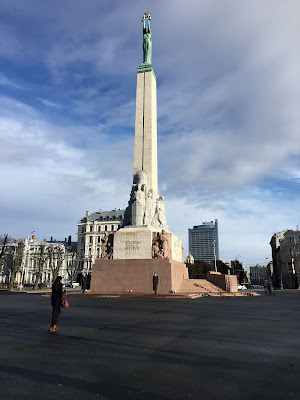A Lavtian or Soviet Monument?

The Freedom Monument When I first saw this monument standing in a square in Riga, I thought it was a left-over of the Soviet era when Russia ruled the Latvians. I was actually surprised that the Latvians hadn't torn it down after the occupation was over in 1991. I now admit that I was wrong. This monument, labelled The Freedom Monument, was built in 1935 by the Latvians to commemorate the freedom that they won in 1920. Before that, Latvia was ruled by Russia, Poland, Finland, or Germany in different periods of time. Finally, after World War I, the Latvians managed to throw out the foreign armies and gain independence. Two years later they wrote and adopted their constitution. The people of Latvia collected donations to build this monument as a remembrance of the people who died in the battles of 1919 and 1920 to gain the freedom. The 42 meter tall monument is inscribed with the words "For Fatherland and Freedom" on the pedestal. The base of the statue is sur


